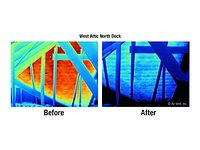
From Football to Roofing
One of the hottest trends on the music scene today is the reemergence of the so-called “garage bands” — defined, according to the Detroit Free Press, as bands that play “stripped-down but propulsive arrangements, a reverence for the blues and a love for Detroit rock heroes such as the Stooges and MC5.”Does this have anything to do with roofing? Well, no, but we recently spoke to Jim Petersen, CEO of Petersen-Dean Inc., San Francisco, whose company began in a garage, and is now one of Northern California’s largest roofing contractors.
The company that started in such humble beginnings in 1983 is now celebrating its 20-year anniversary and currently has locations in San Francisco; Sacramento, Calif.; Newark, Calif.; Anaheim, Calif.; and Phoenix.
The Elements of Success
While today’s garage bands find success by tapping into the essence of rock and roll in its elemental form, Petersen-Dean has moved from the garage to five operating locations by focusing on customer service. “I noticed that firms I had been working for had a lack of concern for the consumer and a cut-corners mentality,” says Petersen. “I believe in basic please and thank you and follow up — the fundamental principles of customer service. Underpromise and overdeliver.”The other half of the success equation is the company’s staff, from the office workers to the field crews. Petersen-Dean gives its office workers three hours of personal catch-up time during the month so they can pay bills, run errands, etc. — things they might not otherwise get to after work. They also get a floating personal holiday in addition to the other holidays, and benefits including 401K, deferred comp, and medical, dental and vision insurance coverage. In addition, Petersen notes that the company includes workers’ family in employee-appreciation-day type events.
And then there is the issue of quality, without which no business can survive. Petersen-Dean’s tag line is “Doing Roofs Right,” and Petersen emphasizes that the company clearly writes its specification on every contract; and the specification comes from the Uniform Building Code.

Safety First
Not surprisingly, Petersen-Dean recognizes that the principle of “Safety First” is critical. “Inexperienced help needs the right kind of training, otherwise, there is a loss of productivity,” says Petersen. “They need to be aware of their surroundings and use equipment properly. You need to emphasize safety or else there will be accidents. You can’t just put people on the roof.”On Jan. 1, 2002, Petersen-Dean instituted a mandatory fall-protection safety policy for all of its roofers in California and Arizona. The policy requires all Petersen-Dean roofing employees to wear a full harness and lifeline when they are working on two story or taller structures. Employees must also wear a full harness and lifeline when working on single-story roofs where the slope exceeds 5:12.
The company has instigated mandatory safety training for new hires. When hired on, each worker receives a construction bucket that includes their own hardhat, safety harness, safety glasses and a copy of Petersen-Dean’s Code of Safety Principles. Each worker must have these items present on all jobs, at all times. They also receive an overview of general job-site safety principles, followed by installation training on one of the company’s training roofs.
In the summer of 2002, the company held safety barbecues at each of its divisions. At those events, workers brought their safety buckets so that the safety directors could verify that the equipment was in good working condition and met safety requirements.
Challenges
Lower insurance rates aren’t the only reason to have a perfect safety rate, but it is a big consideration. “This business is now a risk game,” says Petersen in regard to general liability and construction defect litigation. “We are always aggressive and fight hard.” Generally though, it is difficult for residential contractors to get coverage. Petersen is proud of the fact that his company was the only one to be rewritten by AIG.Petersen feels that condos and houses were built better in the past. “I trained with the unions. When unions declined, housing quality did as well,” he says. “Homeowners aren’t happy. Plaintiffs’ attorneys became aggressive, and rightly so, but it is perverse today. They have found a profit center. Insurance companies are remiss as well; it’s not a quality-first basis. And [a high percentage] of the money paid in settlements is never used to fix defects, it’s spent on other stuff, not to mention the lawyers are getting their cut.”
As for mold, Petersen had experience with the issue when he served on the board of education for the Fremont Unified School District from 1996 though 2000. In an interview he gave to Silicon Valley biz ink, Petersen explained that during his time on the board, a lot of custodians and teachers were taking medical leave. It was discovered that the ailments were potentially mold-related, and the older schools didn’t have the money to remedy the situation.
Petersen points out that mold is now considered a “personal injury” and insurance carriers have mold exclusions. Mold has changed the way his company does business. Petersen believes mold is another way for trial lawyers to make money, and says, “It could be the downfall of homebuilding.”
Projects
One recent challenging project for Petersen-Dean was the Palm Valley job in San Jose, a $1.6 million, 1100-unit mid-rise project for Barbaccia Homes. This new construction job called for Pioneer Regal S-Tile on several different types of roofs – from apartment buildings to plazas.Though never having worked with the general contractor before, Petersen-Dean had been referred by another GC and was invited to bid. The company had the right price, a good reputation and a record of past performance to help close the deal. Petersen-Dean could also offer the biggest fleet machinery, including dump trucks and forklifts — all the heavy hitters necessary to do the job.
The Palm Valley job began in the summer of 1999 under the direction of lead foreman Francisco Tinajero Jr., a five-year Petersen-Dean veteran, and Ron Vincent, general superintendent, who has been with the company for 18 years.
This job was complicated by the fact that the building site was located on two busy intersections. “There was a lot of planning, strategizing and thought process involved, it was not a cost-first deal,” says Petersen.
Another challenge, according to Vincent, was the job schedule, designed to limit noise for the homeowners: “We were only able to work five days a week — Monday through Friday from 8:00 to 5:00.” This restriction reduced the time allowance for loading the roofs. One phase of the Palm Valley job included five-story towers that couldn’t be roof loaded, so crews had to hand carry product.
To add to the degree of difficulty, all of the buildings were built over an underground parking garage, meaning the only access was from the outside. There was also a weight limit for equipment. And of course, Petersen-Dean had to schedule product delivery because of traffic control for the homeowners. Vincent also mentions that on this job, they had “interaction with trades that weren’t up to par.”
Safety issues on the Palm Valley job involved working around scaffolding, working above other trades, and being in the midst of homeowners’ living space. “Normally we have a three-day grace period before other trades comes in,” says Vincent. “But the demand for the housing is what really pushed this job. As they sold phases, homeowners were moving in during completion of the project.”
All in all, though, Petersen-Deans relied on its strengths to do a first-class job. “We take great pride in what we do,” says Vincent. He explains that the company’s upper management takes care of its superintendents and deals with them in a professional manner. The superintendents, in turn, show the same consideration for the roofers and this results in a smooth working relationship.
He again emphasizes Petersen-Dean’s good reputation and its supply of fleet machinery that help the company get jobs and do them well. “We’re not afraid of any job,” he says. “We will tackle it.”
End Notes
Recently, Petersen-Dean sent out a press release announcing a new partnership with the United Union of Roofers, Waterproofers and Allied Workers. Pursuant to the terms of the agreement, which the parties negotiated for almost two years, Petersen-Dean will become the largest residential roofing tile contractor in Northern California to sign with the Union. The agreement covers all of Petersen-Dean’s Northern Californian workers and thousands of roofing projects from Fresno to the Oregon border.Says Petersen, “Partnering with Local 81 will help ensure that our workers will continue to receive the highest level of training while still allowing us to complete jobs on time and on budget.”
In closing, Petersen reiterates that the secret to success is really the basics – “starting with the estimate, build with uniform building code, build properly, be mindful of customer needs, expand warranties, follow up.”


